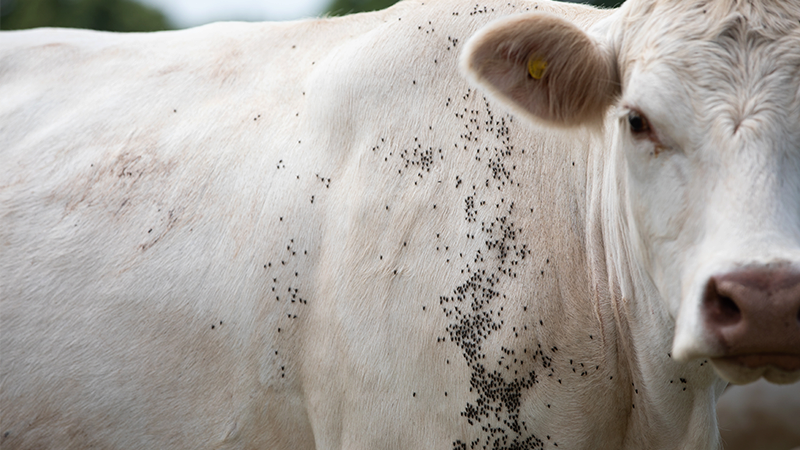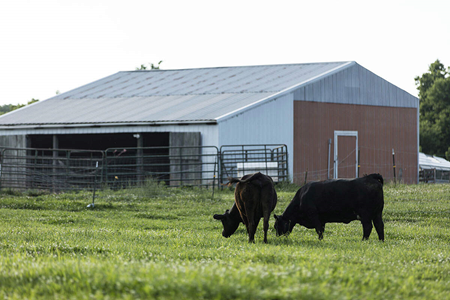
Horn flies are one of the biggest threats for cattle production in the United States and elsewhere. The flies cause significant losses in beef and dairy animals by reducing weight gain and milk production. Various groups and individual producers have anecdotally reported reduced horn fly populations when feeding various garlic products as granules, powders, oil, etc. Chris Holderman notes, “there’s been a lot of conversations and anecdotal evidence that people have fed garlic and they're seeing fly control or they're claiming that they're seeing fly control." Despite these claims, there is a notable lack of peer-reviewed scientific publications to support or refute these assertions.
Pesticides are regulated in the United States principally by the Environmental Protection Agency (EPA). In the case of feed-through insecticides, they can be registered through the EPA as traditional insecticides or individual State's pesticide office as FIFRA exempt products. FIFRA exempt products are commonly called "25 (b)". Traditional insecticides are required to demonstrate effectiveness and safety, among other requirements according to EPA regulations. The 25 (b) insecticides take their name from the Code of Federal Regulations, Title 40, volume 25, section 152.25 (40 CFR §152.25), the section of the code that regulates their use. These 25 (b) insecticides, such as garlic-containing fly control products, have state-level requirements, in addition to specific information required to be listed on the label. To the best of our knowledge, neither the US EPA nor any State Pesticide Offices contain registrations for garlic-containing products intended as a feed-through to control flies. Marketing and sale of products to control public health pests (such as many fly species) without registration is illegal.
To test the viability of including garlic into cattle feed, we initiated a controlled field study and monitored the horn fly populations for 14 weeks. Due to a hurricane during week 3, no data was collected. Otherwise, the study was completed as described.
Study Design and Methodology:
- Location and Setup: The cattle were pastured in Louisiana, with the control group remaining in the original pasture and the treatment group moved to a new pasture approximately one mile away.
- Feeding Regimen: Both groups targeted a consumption rate of ¼ to ½ pound of mineral product per animal per day (equivalent to 8.5-17 g/head/day of garlic).
- Monitoring: Weekly horn fly counts were conducted at random on 15 of the 20 animals in each group. Mineral consumption was also monitored weekly.
Holderman detailed the study's setup: "We took one group of these mama cows and fed them garlic in their mineral and we took the other group and just fed mineral by itself. We monitored the horn fly population for our study period. The horn fly counts were obtained every week."
The first few weeks showed a larger number of horn flies on control group animals, as would be expected due to the control animals not being moved to new pastures at the study start. All animals had horn flies prior to the study start, and it was assumed the manure in the pasture that originally contained all 40 animals with developing flies continued to produce adults that were counted on the control animals. By week 4, the numbers of horn flies in each group were similar and remained similar throughout the duration of the study. Weeks 11-12 showed slightly more horn flies on the controls, but this number was not meaningful. Average mineral consumption was 1.1 lb./h/day for both groups, consumption ranged from 0.34-3.72 lb./h/day in the control group and was 0.48-3.08 lb./h/day in the garlic group. No attempt was made to reduce consumption over target feeding rates.
Holderman summarized our findings: "In our study, feeding these two groups of cattle for about 90 days, we didn't really see any impact of the garlic. For our sales team, this study supports what we've been saying for years is that there is no published evidence that garlic works, and our field study supports that."
From week 4 to the end of the study, if measured as percent effectiveness, feeding garlic reduced the horn fly population by 25%. On average, this was 26 fewer individual flies per animal. A traditionally registered pesticide (through EPA) is expected to have 90% or greater efficacy. The 25 (b) insecticides are expected to maintain at least 80% efficacy. In this study, feeding garlic to cattle did not have a meaningful impact on horn fly numbers throughout most of the study period. When impacts were observed, they were below the minimum expectations required of products, whether or not they are FIFRA exempt 25 (b).
Holderman offered his perspective on the market behavior: "I think the driver for this kind of market behavior comes from, uh, people want to pick greener technologies. And it's coming from a good place. But unfortunately, there's not really any evidence that these things work as a feed-through."
Learn more about our study and findings of garlic as a feed-through to control horn flies in the video below!


